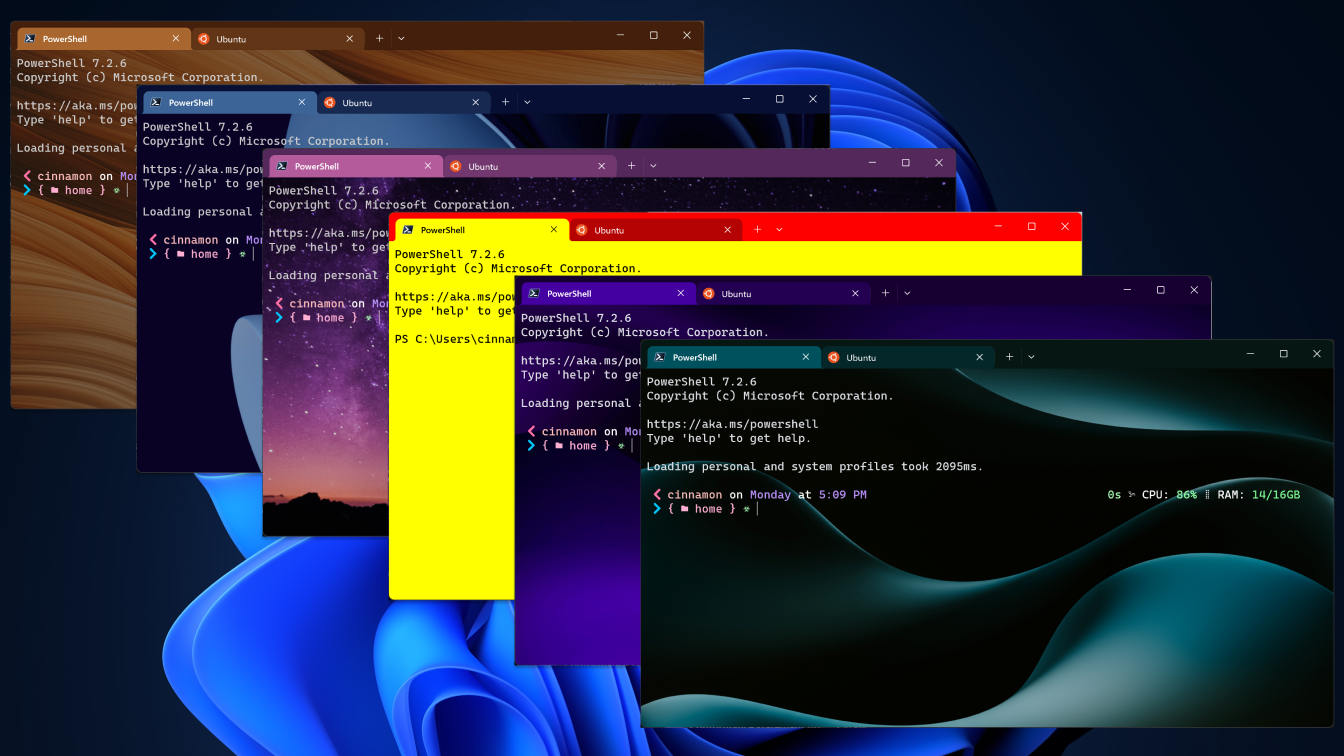Microsoft adds new cosmetic options to Windows Terminal
Making the customisations requires a little programming knowledge but can be done easily and quickly to give Windows Terminal a completely new look


An update to Windows Terminal coming this week will deliver users the ability to create custom themes for the command-line interface (CLI).
Version 1.16 of Windows Terminal Preview will allow users with a little programming experience to customise the look of the CLI’s window with a variety of colours, backgrounds, and themes.
It replaces the minimal customisation options that have previously been included in Windows’ default CLI for years.
Customisation is only available through the modification of a JSON file, but this will be made accessible through the Terminal's user interface (UI) via the Appearance page in the settings dropdown menu.
The programming of the custom themes will be familiar to those with coding knowledge - it’s a case of adding properties to the ‘themes’ object and setting values for each, such as hex codes for specific colours.
Customisation options include separate designs for tabs, tab rows, and the window itself, each of which supports different properties with which users can experiment.
There are other minor cosmetic changes to the default colour scheme, too, and Microsoft has also changed Terminal to a dark theme by default.
Get the ITPro daily newsletter
Sign up today and you will receive a free copy of our Future Focus 2025 report - the leading guidance on AI, cybersecurity and other IT challenges as per 700+ senior executives
In addition to the visual changes brought in version 1.16, Microsoft has made the previously experimental text rendering engine, introduced in version 1.13 and only enabled through a special command, the default for all Windows Terminal profiles.
“The new renderer is more performant and now supports additional pixel shaders (including the retro effect), bold text, and underline/overline/hyperlink lines,” said Kayla Cinnamon program manager 2, Windows Terminal, console, command line, and Cascadia Code, in a blog post.
“If your machine doesn’t have a GPU, or you’re remoting to a virtual machine that doesn’t have a GPU, it will fall back to a more performant mode that doesn’t require hardware support.”
Microsoft has been planning to make Windows Terminal the default terminal for its operating system since December 2021, it said at the time.
This was made official at the end of August when it was enabled as standard in the Windows 11 Insider preview build 25188.
RELATED RESOURCE

Organisations accelerating their digital workplace achieve improvements
See the biggest return on device investments
It replaced the Windows Console Host which has been the default terminal emulator since Windows began, Cinnamon said, tasked with bringing programs like Command Prompt and PowerShell to life.
“Over the course of 2022, we are planning to make Windows Terminal the default experience on Windows 11 devices,” she said.
“We will start with the Windows Insider programme and start moving through rings until we reach everyone on Windows 11. We would love to have your feedback while we are working on this to help iron out all of the bugs and ensure everyone has a great experience with Terminal.”

Connor Jones has been at the forefront of global cyber security news coverage for the past few years, breaking developments on major stories such as LockBit’s ransomware attack on Royal Mail International, and many others. He has also made sporadic appearances on the ITPro Podcast discussing topics from home desk setups all the way to hacking systems using prosthetic limbs. He has a master’s degree in Magazine Journalism from the University of Sheffield, and has previously written for the likes of Red Bull Esports and UNILAD tech during his career that started in 2015.
-
 The Race Is On for Higher Ed to Adapt: Equity in Hyflex Learning
The Race Is On for Higher Ed to Adapt: Equity in Hyflex LearningBy ITPro
-
 Google faces 'first of its kind' class action for search ads overcharging in UK
Google faces 'first of its kind' class action for search ads overcharging in UKNews Google faces a "first of its kind" £5 billion lawsuit in the UK over accusations it has a monopoly in digital advertising that allows it to overcharge customers.
By Nicole Kobie
-
 Enterprises are doubling down on IT optimization strategies – and it’s delivering huge financial returns
Enterprises are doubling down on IT optimization strategies – and it’s delivering huge financial returnsNews Organizations that have cracked IT cost optimization and innovation reap the rewards both financially and in terms of time to market.
By Emma Woollacott
-
 The race is on for higher ed to adapt: Equity in hyflex learning
The race is on for higher ed to adapt: Equity in hyflex learningWHITEPAPER Fulfil student and faculty needs
By ITPro
-
 Unlock the potential of LATAM’s booming crypto market
Unlock the potential of LATAM’s booming crypto marketwhitepaper Strategic pathways for crypto companies looking to expand into Latin America
By ITPro
-
 Practical ergonomics guide for education
Practical ergonomics guide for educationWHITEPAPER Save energy, focus, and promote overall well-being
By ITPro
-
 The online cash revolution
The online cash revolutionwhitepaper Why adding eCash to the checkout unlocks more growth
By ITPro
-
 How to manage – and mitigate – performative working
How to manage – and mitigate – performative workingFeature An increasing number of people are putting on a show of working, rather than actually getting on with it
By Peter Ray Allison
-
 How payments support the growth of software platforms
How payments support the growth of software platformswhitepaper Discover how Paysafe can help drive the growth and success of your software platform
By ITPro
-
 The ultimate guide to 3D
The ultimate guide to 3DWhitepaper Creative boost breaks
By ITPro